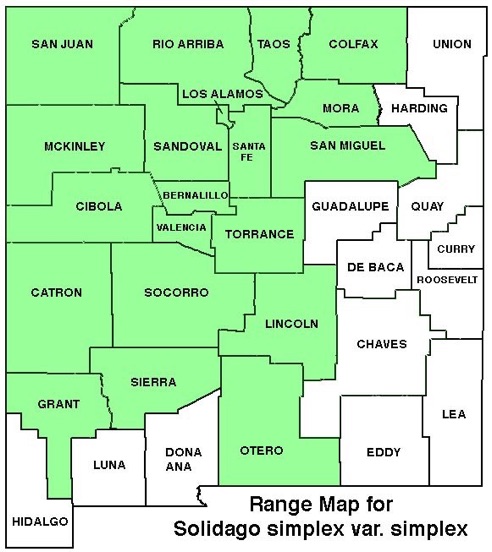WILDFLOWERS OF NEW MEXICO

Stems 6–24 inches tall are mostly hairless and the flower heads sometimes sticky; lower leaves spatulate-shaped, flower clusters on branch tips are elongated to spreading. The leaves along mid-stem are similar in size then smaller at the top, and the flowers grow on all sides of the branching stems (not just on one side). Note the heads have 8 yellow rays, basal are present at flowering, and the basal leaf stalks (petioles) are not lined with ciliate hairs. This species does not spread by rhizomes. Also called mountain, decumbent, and narrow goldenrod.
FLOWER: July–September. Clusters on the stem ends are elongated to rounded with up to 150 flower heads; phyllaries unequal, and often resinous sticky, which is a distinctive characteristic; usually 8 yellow ray florets; flower stems hairless or with few tiny, flat-lying hairs.
LEAVES: Basal and alternate on stem. Basal and lower leaf blades spatula-shaped, 2–4 inches long (5–10 cm) to 3/4 inch wide (19 mm), with tapering, wing-like stalks (petioles), not lined with ciliate hairs; stem leaves few, lance-shaped to linear, 1/2–2 inches long (1.25–4.7 cm), sessile (stalkless), margins entire to sparsely toothed, top leaves smallest.
HABITAT: Dry sandy, gravelly, loamy soils of mountain meadows, open forests, slopes, drainages, roadsides, disturbed areas; ponderosa-Douglas fir, mixed conifer forests.
ELEVATION: 6,800–12,550 feet.
RANGE: AK, AZ, CO, ID, MI, MN, MT, NM, ND, OR, SD, UT, WA, WV, WY; Canada, Mexico.
SIMILAR SPECIES: Variety simplex is widespread in NM and occurs through the West from Alaska to Mexico. The Simplex species group is complex and varies significantly both taxonomically and genetically across its widespread range. It has been revised numerous times in the past. Currently, Flora of North America recognizes 2 subspecies and 7 varieties. The variety simplex has gone through 13 different name changes. Flora Neomexicana III (Allred, 2020) delegates it to a separate species, S. glutinosa. Rocky Mountain Goldenrod, S. multiradiata, scattered in western NM, has upper leaves broadest at the base and edges lined with long ciliate hairs, is densely short-hairy in the flower cluster, and its heads usually have 13 yellow rays.
NM COUNTIES: Mountains in northern and western half of NM in mid- to high-elevation, dry habitats: Bernalillo, Catron, Cibola, Colfax, Grant, Lincoln, Los Alamos, McKinley, Mora, Otero, Rio Arriba, San Juan, San Miguel, Sandoval, Santa Fe, Sierra, Socorro, Taos, Torrance, Valencia.









STICKY GOLDENROD
SOLIDAGO SIMPLEX VAR. SIMPLEX (aka Solidago glutinosa)
Aster Family, Asteraceae
Perennial herb


















THE CONTENTS OF THIS WEBSITE ARE COPYRIGHTED AND CANNOT BE USED
WITHOUT PERMISSION OF GEORGE OXFORD MILLER
















EMAIL ME













































Spatula-shaped basal leaves don’t have ciliate hairs along the margins.

Flower clusters can be elongated or rounded, and grow all around the flowering stems that make up the clusters (not just on one side).
Stem leaves are without stalks (sessile).

Flower heads usually have 8 small rays around a yellow disk.

• Robust plants can have more than 100 flower heads in a cluster (upper arrow).
-
•Stems are mostly hairless.
-
•Basal leaves are present at flowering (lower arrow).









